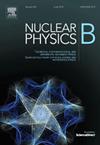Interpretation of complexity for spherically symmetric fluid composition within the context of modified gravity theory
IF 2.5
3区 物理与天体物理
Q2 PHYSICS, PARTICLES & FIELDS
引用次数: 0
Abstract
Regardless of the adequate descriptions of complexity in distinct alternative gravity theories, its elaboration in the framework of theory remains uncertain. The orthogonal splitting of the curvature tensor yields the complexity factor as suggested by Herrera [1]. To commence our study, the inner spacetime is assumed to be spherically symmetric static composition comprised of the anisotropic fluid. In this context, we derive the modified field equations for the considered theory and take into account the established relationship between the conformal and curvature tensors to interpret the complexity. Furthermore, we determine the correspondence of the mass functions with the complexity factor, represented by a specific scalar . Certain solutions complying with the precedent of diminishing are also evaluated. It is noted that celestial formations having anisotropic and non-uniform compositions of matter assert the utmost complexity. Nevertheless, the spherically symmetric matter distribution may not exhibit complexity in the scenario of vanishing impacts of non-homogenous energy density and anisotropic pressure due to the presence of dark source terms associated with this extended gravity theory.
求助全文
约1分钟内获得全文
求助全文
来源期刊

Nuclear Physics B
物理-物理:粒子与场物理
CiteScore
5.50
自引率
7.10%
发文量
302
审稿时长
1 months
期刊介绍:
Nuclear Physics B focuses on the domain of high energy physics, quantum field theory, statistical systems, and mathematical physics, and includes four main sections: high energy physics - phenomenology, high energy physics - theory, high energy physics - experiment, and quantum field theory, statistical systems, and mathematical physics. The emphasis is on original research papers (Frontiers Articles or Full Length Articles), but Review Articles are also welcome.
 求助内容:
求助内容: 应助结果提醒方式:
应助结果提醒方式:


